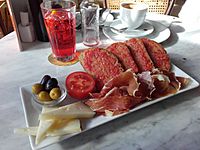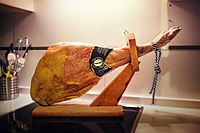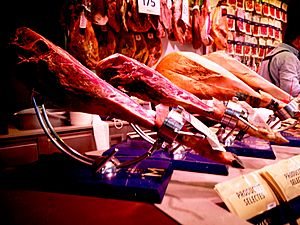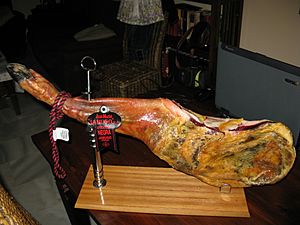Jamón facts for kids

Jamón
|
|
| Alternative names | Jamón serrano |
|---|---|
| Course | Tapas, appetizer |
| Place of origin | Spain |
| Serving temperature | Room temperature |
| Main ingredients | Ham |
| Variations | Jamón Ibérico |
Jamón (pronounced ha-MON) is a special type of dry-cured ham made in Spain. It's one of the most famous foods from Spanish cuisine around the world. You'll often find jamón served as part of tapas, which are small Spanish snacks.
Most jamón is usually called jamón serrano in Spain. The word jamón simply means "ham" in Spanish. So, other ham products made or eaten in Spanish-speaking countries might also be called jamón.
Contents
What is Jamón?
Jamón is typically eaten in thin slices. These slices can be cut by hand from a pig's back leg using a special thin knife. The leg is held steady on a stand called a jamonero. Sometimes, the meat is deboned and cut with a machine called a rotary cold-cut slicer. You can also enjoy jamón in small pieces of any shape.
Jamón is similar to presunto from Portugal and prosciutto from Italy. However, jamón is cured for a longer time, sometimes up to 18 months. This longer curing process makes it drier, gives it a deeper color, and a stronger flavor.
A whole jamón leg with the bone is much cheaper than buying it already sliced. This is because it includes the bone and fat that you don't eat. Once you start cutting into a jamón leg, it begins to dry out. So, it's best to eat it fairly quickly. Restaurants and shops use jamón very fast, so this isn't a problem for them. But for people at home, it's often easier to buy jamón that is already sliced. You can find it freshly cut from a deli, or pre-packaged and vacuum-sealed. A whole jamón leg stays good for a long time if kept in a cool, dry place away from sunlight. But once you cut it, you should keep the cut pieces in the refrigerator.
In some parts of Spain, jamón is also smoked. This type of ham is often made for people to eat at home. It's common in southern areas of Castile and León and parts of Extremadura. Smoked jamón has a firmer texture and a smoky, salty taste.
Jamón is widely available in Spain, though it can be expensive. It's also found in some countries in the European Union. However, in other countries, special taxes or rules about importing meat can make jamón very expensive and hard to find.
There are two main types of jamón you'll see in stores. These types depend on the pig breed and special labels that protect where the ham comes from:
- Jamón ibérico: This ham comes from the black Iberian pig. It is known around the world as a special and expensive food.
- Jamón serrano: This means "mountain ham". It includes most other types of jamón.
-
A jamón serrano leg from Teruel in a cutting stand
Jamón serrano
The name jamón serrano ("mountain ham") is often used for all dry-cured jamón made in Spain. This helps tell it apart from jamón de York, which is a cooked ham.
More specifically, jamón serrano refers to jamón made from white pigs or pigs that are not the special Ibérico breed. This is the most common type of jamón eaten and produced in Spain. Most jamones serranos come from white pig breeds like the Duroc. Jamón serrano is also known by names like jamón reserva, jamón curado, or jamón extra.
Jamón serrano has a special status in the EU and the UK called TSG (Traditional Speciality Guaranteed). This means that the product has certain qualities that make it unique. It also means that its ingredients or how it's made have been the same for at least 30 years.
How Jamón serrano is made
Making jamón serrano takes several steps:
- First, fresh hams are cleaned and trimmed.
- Then, they are covered with salt for about two weeks. This helps remove extra water and keeps the meat from spoiling.
- After salting, the hams are washed to remove the salt.
- Next, they are hung to dry for about six months.
- Finally, the hams are hung in a cool, dry place for 6 to 18 months. The exact time depends on the weather and the size of the ham.
- These drying places, called secaderos, are usually built in high places. This is why it's called "mountain ham."
Jamón ibérico
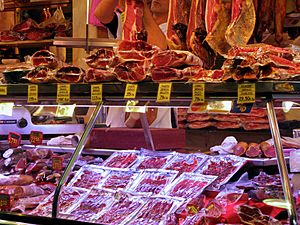
Jamón ibérico is a special type of dry-cured jamón made from Iberian-breed pigs. These pigs are often black. Jamón ibérico is one of the most expensive hams in the world. It has a unique marbled look because of its fatty texture. This makes it a very popular and sought-after food, similar to how special kobe beef is.
Because jamón ibérico is so special and limited, you should be careful when buying it. Sometimes, products are sold as ibérico when they are not real. Spain has rules to help you know if an ibérico product is genuine.
Special EU labels
The European Union (EU) has special labels for some well-known food products. These labels protect the name and origin of the food. For jamón, these labels are called Protected Designation of Origin (PDO) or Protected Geographical Indication (PGI). They tell you that the jamón comes from a specific place and is made in a traditional way.
Some jamón types with these special labels include:
- Jamón de Teruel (PDO status)
- Jamón de Los Pedroches (PDO status)
- Jamón Dehesa de Extremadura (PDO status)
- Jamón de Guijuelo (PDO status)
- Jamón de Huelva (PDO status)
- Jamón de Trevélez (PGI status)
Paleta
The paleta de cerdo or paletilla is a product that looks and tastes like jamón. However, it is made from the front leg of a pig, not the hind leg like jamón. It is cured and eaten in the same way. Since front legs are lighter than hind legs, paletillas are often sold for people to enjoy at home.
A paletilla can also be called Ibérica if it comes from the same special livestock as Jamón Ibérico.
See also
 In Spanish: Jamón de España para niños
In Spanish: Jamón de España para niños


